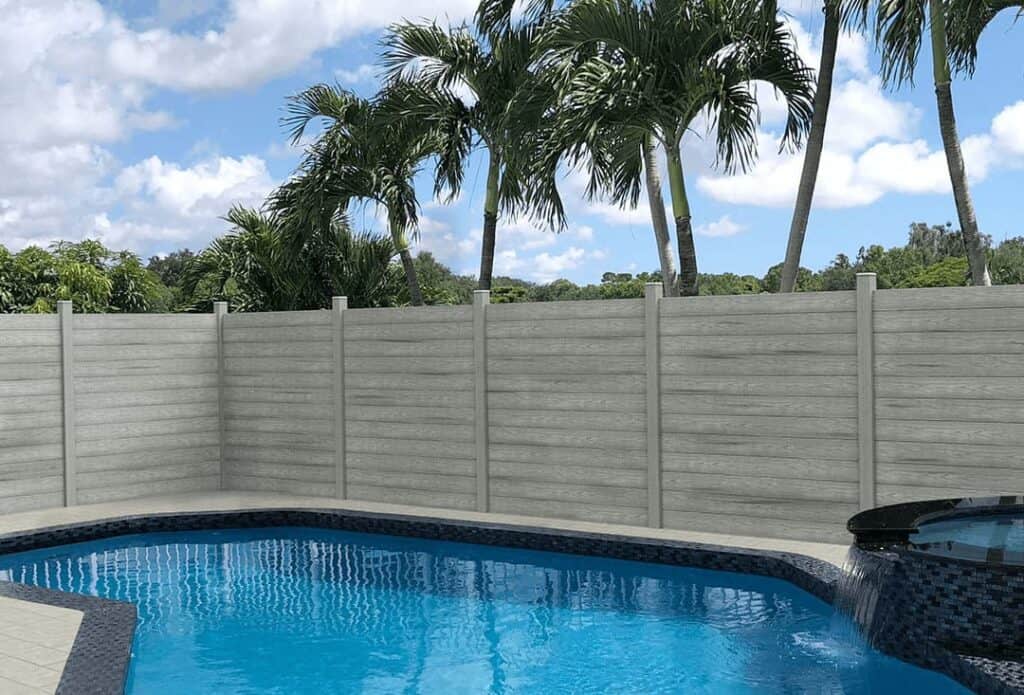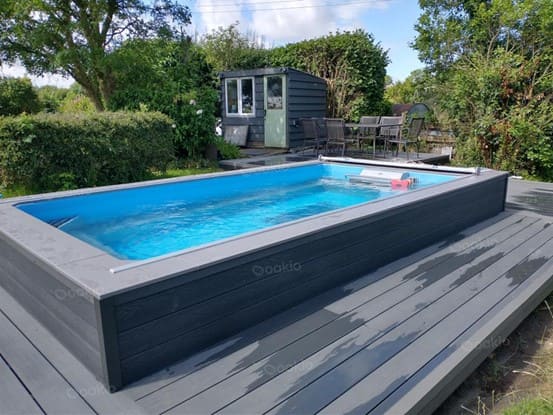How Should WPC Swimming Pool Be Maintained
Maintaining a Wood Plastic Composite (WPC) swimming pool is essential for ensuring its longevity, aesthetic appeal, and safety. WPC pools are known for their durability, eco-friendliness, and ease of maintenance compared to traditional materials. However, proper care is crucial to keep them in top condition. Here, we’ll guide you through the essential steps and best practices on how to maintain wpc swimming pool.
Wood plastic has a strong anti-corrosion ability. Even being exposed to wind and sun in the outdoor, the wood will not rot, crack, or produce cracks. In addition, it also has the ability of anti-ultraviolet and does not need special maintenance. How to maintain WPC swimming pool?

5 Methods on How to Maintain WPC Swimming Pool
Method 1: Maintained WPC Swimming Pool by Regular Cleaning
Weekly Cleaning: Dust, leaves, and other debris can accumulate in and around your pool, affecting the water quality and the pool’s appearance. Use a soft-bristle brush or a leaf skimmer to clean the surface. For WPC decking around the pool, a regular sweep and occasional mopping with a mild soap solution can keep it looking fresh.
Spot Cleaning: Spills, stains, or algae growth on WPC materials can usually be managed with a simple solution of soap and water. For tougher stains, a gentle, non-abrasive cleaner designed for WPC materials can be used. Avoid using harsh chemicals that can damage the composite material.
Method 2: Keep Pool Water Balanced to Maintain WPC Swimming Pool
Keeping the pool water balanced is vital for the comfort of swimmers and the preservation of the pool components. Regularly test the water pH, chlorine levels, and other chemical balances to ensure they’re within the recommended ranges. Unbalanced water can lead to material degradation and affect the appearance of your WPC pool.
Method 3: Inspect and Repair your WPC Swimming Pool
Seasonal Inspections: At the start and end of the swimming season, inspect your WPC pool and surrounding area for any signs of damage, wear, or loose components. Early detection of issues like cracks, warping, or discoloration can prevent more significant problems down the line.
Prompt Repairs: If you find any damage, address it promptly to prevent further deterioration. Most WPC materials are easy to repair or replace, ensuring your pool area remains safe and inviting.

Method 4: Protecting Your WPC Swimming Pool
Cover Usage: When the pool is not in use, especially during off-season months, use a pool cover to protect the water from debris and reduce evaporation. A cover can also help maintain water temperature and chemical balance.
Furniture and Accessories: Ensure that any furniture or accessories used around the pool are suitable for outdoor use and do not damage the WPC decking. Soft pads or protective covers under furniture legs can prevent scratches and dents.
Method 5: Provide Professional Maintenance for your WPC Swimming Pool
While DIY care is sufficient for many aspects of WPC pool maintenance, professional inspections and maintenance can be invaluable, especially for structural integrity, advanced cleaning, or when dealing with complex issues.
Other Tips for Better Maintained your WPC Swimming Pool
Tip 1: Remove dirt and debris
Remove dirt and debris and clean the floor. Need soap, hot water, and a soft-bristle brush.
Tip 2: Remove the line mark
All color lines except white are permanent. We recommend that you use white chalk or baby powder. Using hot soapy water with bleach to remove chalk marks may remove some chalk dust.
Tip 3: Hide and fade visible file marks
The building code requires that there are file marks on one side of the plastic wood/wood plastic board. Most file marks can be hidden by the careful installation. Visible file marks can be diluted with acetone.
Tip 4: Droplet spot
Tannic acid filtration naturally occurs in plastic/wood plastic and all wood-based products. Considering at least 16 weeks of normal weathering, this process may be accelerated by the use of a product containing oxalic acid or phosphoric acid commonly known as a floor whitening agent.
Tip 5: Pigment stain
During the weathering process, a small amount of surface pigmentation will be removed from the surface of plastic wood/wood plastic wood. This may be discoloration of adjacent surfaces. Remove with normal rust remover.
Tip 6: Ice and snow
Calcium chloride or rock salt, which can be seen in many families, can melt the ice on the plastic/wood plastic floor.
Tip 7: Wear and scrape
It will naturally fade or disappear after 12 to 16 weeks of weathering. After weathering, the process of washing floors based on bleach will be faster.
Tip 8: Rust, dirt, and grime at the grind
Use cleaning products containing oxalic acid or phosphoric acid base to reduce or eliminate rust or dirt. It may need to sit down and take 10-15 minutes to fade for the product.
Tip 9: Grease stains
When the stain appears, wipe it with the household common decontamination as soon as possible and wash it with hot water.
Tip 10: Berries and wine stains
Mix bleach powder into hot water according to the bleach package label. Wipe the stain gently and rinse thoroughly. The stain may not disappear completely.
Tip 11: Ink stain
The ink may be permanent. However, scrubbing with hot soapy water can make this stain light and wash thoroughly.
Tip 12: Pressure washer
The pressure washer is not recommended for plastic wood/wood plastic wood. The use and/or application of a quick steel pressure cleaner higher than 1500 and 10 lower than the floor surface may damage the cover plate surface and cause damage beyond the warranty.
Tip 13: Casting mold
Use a traditional detergent or detergent containing sodium hypochlorite (bleach).
Clean your floor regularly (spring and Autumn) even if it is clean, to prevent the accumulation of pollen/debris that may cause the mold to be unusable, it is also very important to clean it.
Tip 14: Sandpaper grinding
The sandpaper is not recommended for plastic wood/wood plastic wood. Sanding will change the surface appearance of plastic wood/wood plastic wood material, which has a great impact on the WPC swimming pool.
Conclusion
Maintaining a WPC swimming pool is straightforward with regular cleaning, water quality management, timely repairs, and protective measures. By following these maintenance tips, you can enjoy a pristine, safe, and long-lasting swimming environment for years to come. Remember, the key to a well-maintained WPC pool is not just the care you put into it but also the enjoyment and relaxation it brings to your outdoor living space.If you need pool deck WPC, please contact us. We are professional WPC manufacturer!
Trending Reading
What Are the Differences Between the WPC Board and PVC Board?
[2024 Update] How Long Does WPC Decking Last?










